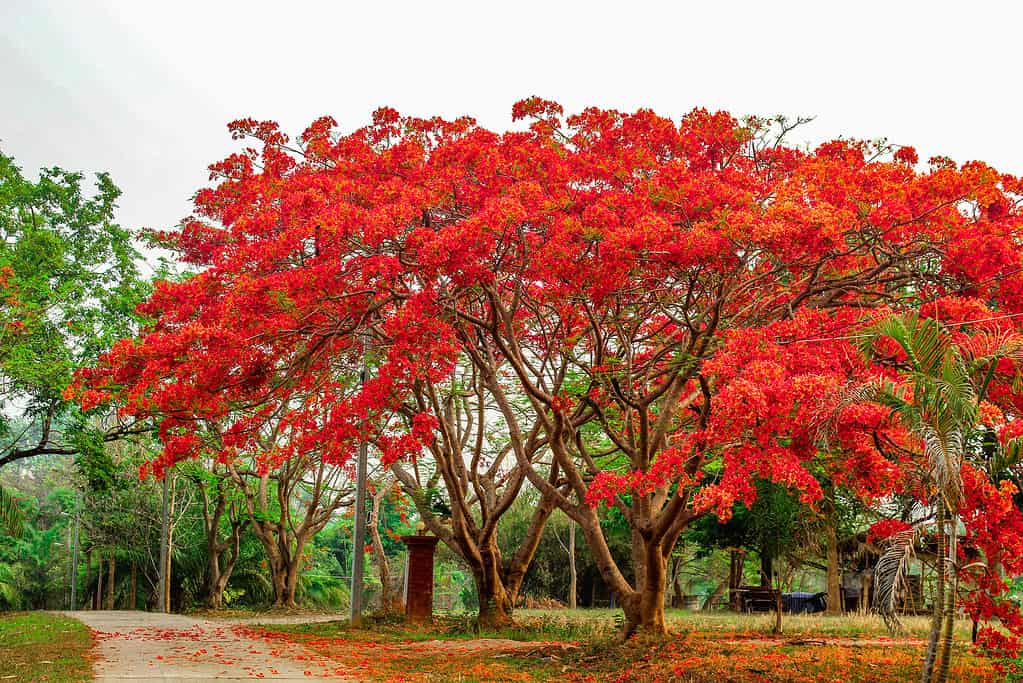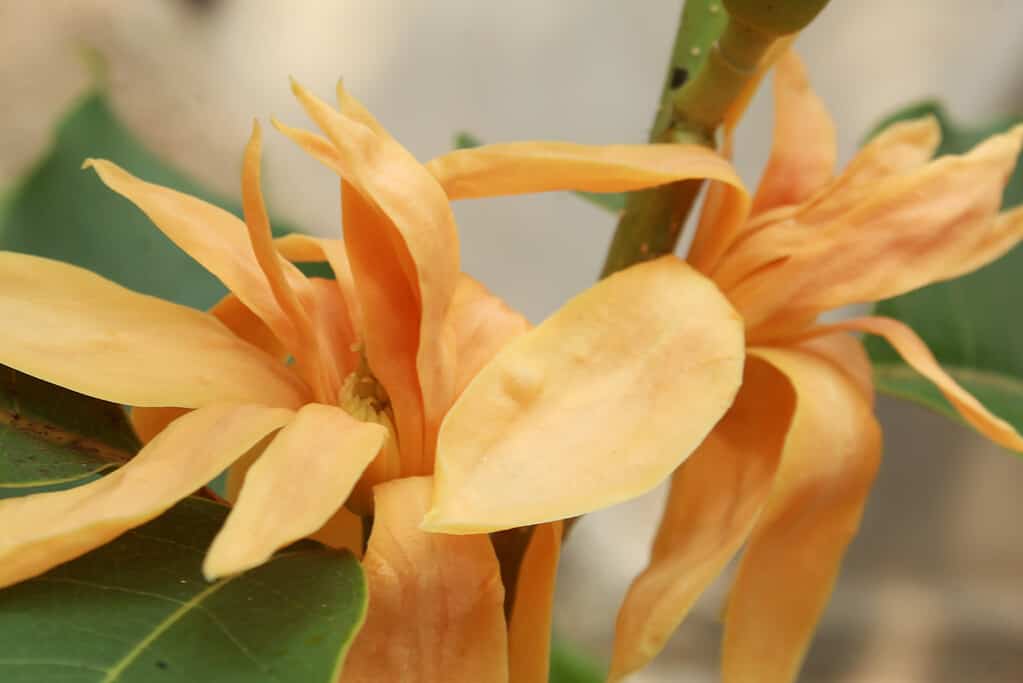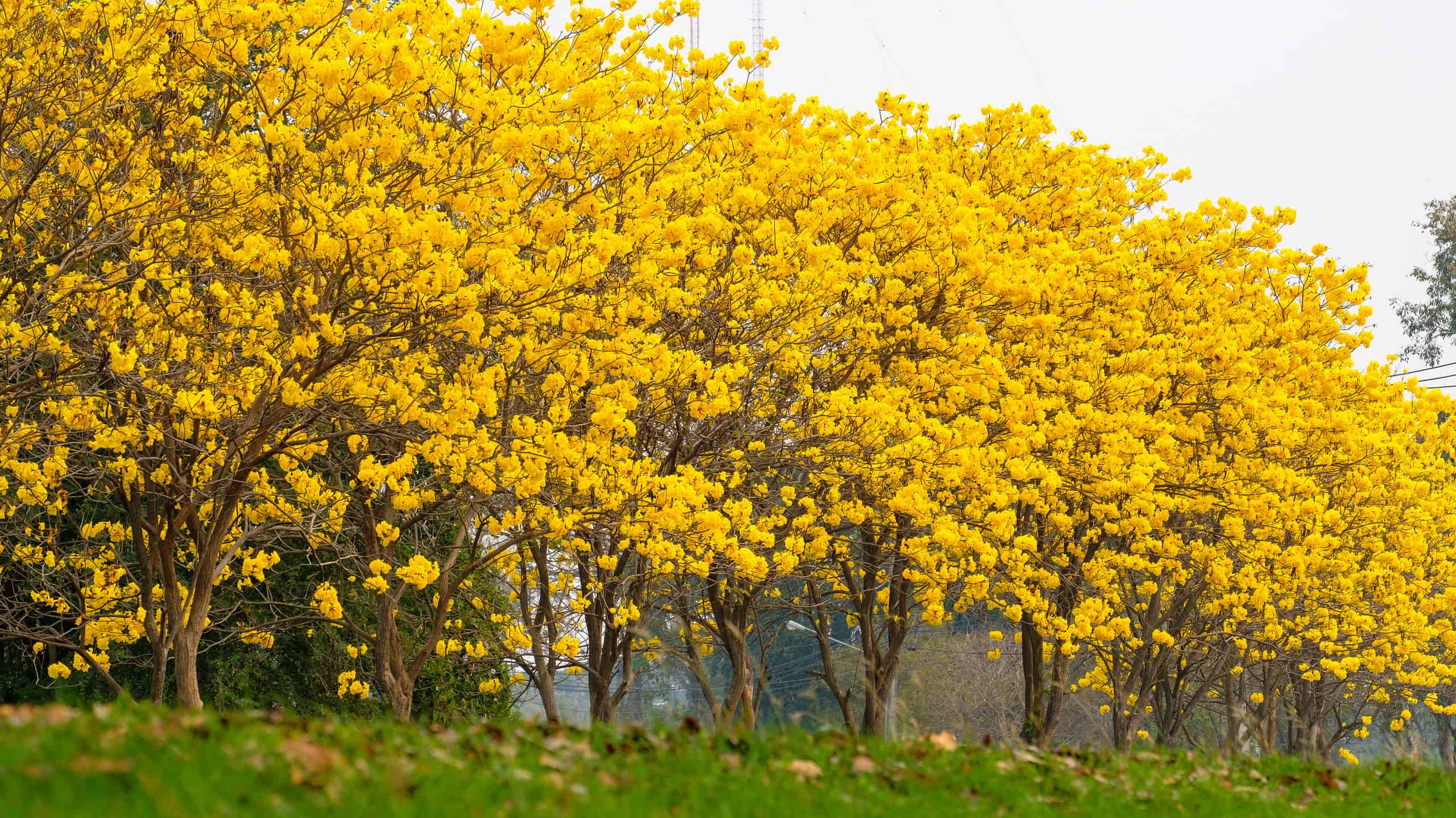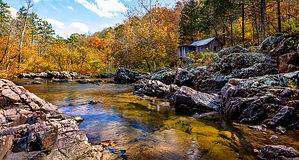In the Sunshine State, vibrant bursts of orange aren’t limited to just the citrus groves. Florida’s landscape comes alive with the stunning beauty of orange flowering trees. These botanical marvels add a splash of color to the subtropical paradise. They create a visual symphony that’s nothing short of breathtaking.
From the northern Panhandle to the southern Keys, Florida’s diverse climate offers a canvas for a variety of orange-flowered trees to flourish. These trees not only dazzle with their vivid blooms but also provide essential ecological benefits, like shelter and food for local wildlife.
In this article, we’ll take you on a journey through Florida’s top orange flowering trees! Whether you’re a seasoned gardener or simply a nature enthusiast, you’ll discover the perfect trees to grace your yard or admire during a stroll through Florida’s outdoor wonders.
1. Geiger Tree

The stunning Geiger tree is believed to be native to the Florida Keys. However, there is still speculation surrounding whether or not that is true.
©M Stock/iStock via Getty Images
Geiger trees, scientifically known as Cordia sebestena, are renowned for their striking orange flowers that adorn their branches. These vibrant blooms make them a picturesque addition to the tropical landscapes of Florida. Geiger trees thrive in the Sunshine State due to their remarkable adaptability to the region’s unique environmental conditions.
The orange flowers of the Geiger tree are a defining feature, attracting pollinators like butterflies and bees. The tree’s blossoms are perennial, so it always adds a splash of color to Florida’s greenery. The lush foliage of this tree makes it an attractive landscaping option in the state of Florida. Summers there are hot and humid.
Geiger trees do well in Florida because they can adapt to many soil conditions. They are also able to thrive on the state’s typical loamy soils and well-drained sandier ones. In addition, these trees can withstand salt, making them an excellent choice for the seaside.
Geiger trees offer several benefits to the environment and the community. Their year-round blooming pattern provides nectar for pollinators, supporting local biodiversity. Moreover, their shade helps cool urban areas, reducing energy consumption for air conditioning during scorching summers. The tree’s dense growth also aids in stabilizing soil and preventing erosion, a crucial function in areas prone to heavy rainfall and hurricanes.
2. Orange Royal Poinciana

Orange royal poinciana trees are native to Madagascar and can grow quite large, up to 40 feet tall.
©Randall W Simpson/Shutterstock.com
The orange royal poinciana tree, scientifically known as Delonix regia, is a majestic and vibrant addition to the landscape of Florida. These trees are characterized by their spectacular orange flowers, which are their most distinguishing feature.
Orange royal poinciana trees thrive in Florida due to several factors that make the state an ideal environment for their growth. To start, they are highly adapted to Florida’s environmental conditions, making them well-suited for the region. Additionally, they can tolerate a variety of soil types, including sandy soils commonly found in Florida, which further contributes to their successful growth in the state.
The benefits of orange royal poinciana trees extend beyond their aesthetic appeal. Their bright orange blossoms are a visual treat for passers-by and a boon to local pollinators like bees and butterflies. Also, during the hot summer months in Florida, these trees give much-needed shade, which helps to both cool the environment and lower energy use. Their large overhangs make for pleasant places to hang out, improving the quality of life for both locals and tourists.
Also, orange royal poinciana trees are effective in stabilizing soil with their extensive root systems, preventing erosion in areas prone to heavy rainfall and storms. This ecological function is particularly valuable in Florida, where rain and hurricanes are common occurrences.
3. Golden Trumpet Tree

The golden trumpet tree is also classified as
Handroanthus chrysotrichus.
©Zelent Iuliia/Shutterstock.com
Golden trumpet trees, scientifically known as Tabebuia chrysotricha, are a sight to behold with their dazzling orange flowers. These trees are a unique and cherished addition to the flora of Florida, adding a burst of vibrant color to the landscape.
Golden trumpet trees thrive in specific Florida hardiness zones, typically doing best in zones 10 and 11. These zones provide a warm and tropical climate that suits the tree’s needs, allowing it to thrive in the Sunshine State. While they can tolerate a range of soil types, they tend to perform best in well-drained soils, which are often found in these regions.
What sets the golden trumpet tree apart is its striking display of bright orange trumpet-shaped flowers. These flowers create a mesmerizing canopy of color when they bloom, usually in late winter or early spring, transforming the tree into a natural spectacle. The vibrant blooms not only attract the admiration of onlookers but also serve as a beacon for pollinators like bees and butterflies, contributing to local biodiversity.
Just as well, the golden trumpet tree has a unique feature that adds to its appeal: it sheds its leaves just before its peak flowering season. This deciduous nature allows the tree to conserve energy for producing its show-stopping blossoms. As the flowers fall, they create a stunning orange carpet beneath the tree, further enhancing its visual impact.
Beyond their aesthetic beauty, golden trumpet trees also offer some environmental benefits. Their wide canopy provides shade in Florida’s hot climate, helping to cool urban areas and reduce energy consumption. Moreover, their presence can contribute to soil stability, preventing erosion in regions prone to heavy rains.
4. Orange Champaca

The flowers of the orange champaca tree are a light orange-yellow hue.
©MANORANJAN MISHRA/iStock via Getty Images
The orange champaca tree, scientifically known as Michelia champaca, is a captivating botanical wonder known for its enchanting orange flowers. These trees add a touch of elegance and fragrance to the landscapes they grace, making them a unique and cherished presence in Florida.
Orange champaca trees thrive in Florida hardiness zones 10 and 11. These zones offer a warm and damp climate that suits the tree’s requirements for optimal growth. They are particularly well-suited for the balmy and humid conditions of the Sunshine State, where they can reach their full potential.
What sets the orange champaca tree apart is its exquisite flowers. These blossoms are a vibrant orange, emanating a delightful and intoxicating fragrance. The scent is reminiscent of jasmine and permeates the surrounding air, making it a favorite among gardeners and nature enthusiasts. The fragrant flowers attract pollinators like bees and butterflies, contributing to the local ecosystem.
One of the special qualities of the orange champaca tree is its use in perfumery. The aromatic oil extracted from its flowers, known as champaca absolute, is a prized ingredient in the perfume industry. This fragrance is highly sought after for its unique and exotic scent, making it a valuable resource for perfumers worldwide.
Aside from their aromatic allure, orange champaca trees also offer aesthetic value with their glossy green foliage and graceful appearance. They can provide shade and enhance the beauty of gardens and parks, creating serene and inviting spaces for relaxation.
5. Jamaican Rain Tree

The flowers of the Jamaican rain tree or “monkey pod” tree are very unique-looking with very thin, orange petals.
©SUMAR TOYO/iStock via Getty Images
Jamaican raintrees, scientifically known as Samanea saman, are distinctive and captivating trees that can be found in Florida. These trees are renowned for their vibrant orange flowers. They lend a touch of tropical beauty to the landscapes where they thrive.
Jamaican raintrees tend to do best in Florida hardiness zones 10 and 11. This is thanks to the state’s warm and tropical climate. Their preference for these zones is due to the temperature and humidity conditions that closely resemble their native habitats. In these regions, the trees can reach their full potential, showcasing their unique characteristics.
What makes the Jamaican raintree truly unique is its foliage and canopy. The tree boasts large, fern-like leaves that provide a dense and expansive canopy, creating a wide umbrella of shade. This feature makes it a popular choice for landscaping in Florida, as it offers relief from the scorching sun, making outdoor spaces more comfortable and enjoyable. The broad canopy also serves as an inviting habitat for various wildlife, further enriching the local ecosystem.
Also, Jamaican raintrees have a fascinating behavior that sets them apart. They are known for their “sensitive leaflets” – when touched or exposed to strong winds, their leaflets fold together, akin to an umbrella closing. This unique response to external stimuli has earned them the nickname “rain tree” as it can appear as if the tree is preparing for rain.
6. Flame of the Forest

The fiery flame of the forest tree is native to tropical areas of southern Asia, such as India, Sri Lanka, Thailand, and more.
©MUHAMMAD ALTAF HUSSAIN/iStock via Getty Images
Flame of the forest trees, scientifically known as Butea monosperma, are striking and distinctive trees known for their fiery orange-red flowers. While not native to Florida, these trees can still thrive in certain regions of the state, particularly in the warmer and tropical zones.
Flame of the forest trees typically do best in Florida hardiness zones 10 and 11. These zones offer the right climate that mirrors their natural habitat. This allows them to flourish with little human intervention or maintenance. The trees are well-suited to Florida’s conditions, as they are drought-tolerant and can adapt to a variety of soil types, including sandy soils often found in the state.
What makes the flame of the forest tree unique is its dazzling display of brilliant orange-red flowers. These blossoms create a vivid spectacle when they bloom, usually in late spring or early summer. The tree gets its name from these fiery blooms, which resemble a burst of flames against the green backdrop of its foliage. The vibrant flowers attract pollinators like bees and hummingbirds, contributing to local biodiversity.
Moreover, the flame of the forest tree is dry-season deciduous, meaning it sheds its leaves in the dry season before the flowers appear. This leafless phase accentuates the striking beauty of the blossoms, creating a stunning contrast and making it a captivating sight for onlookers.
In addition to their aesthetic appeal, the flame of the forest trees provide valuable shade in Florida’s hot climate. Their broad, umbrella-like canopies offer relief from the scorching sun, making them popular choices for landscaping and enhancing the comfort of outdoor spaces.
7. Sweet Osmanthus

The delightful sweet osmanthus is also known as fragrant osmanthus due to its pleasant smell. They are also known for their very light, pale, yellow-orange petals.
©Marinodenisenko/Shutterstock.com
Sweet osmanthus trees, scientifically known as Osmanthus fragrans, are eye-catching additions to Florida’s diverse flora. These trees are distinguished by their fragrant orange flowers, which not only add beauty to the landscape but also fill the air with a delightful scent.
In Florida, sweet osmanthus trees thrive best in hardiness zones 8 through 11. They prefer a climate that offers mild winters and warm, humid summers, making regions of the state like North and Central Florida particularly suitable for their growth. Additionally, they can adapt to a variety of soil types, which is advantageous in a state with varying soil conditions.
The unique feature of sweet osmanthus trees lies in their flowers and fragrance. The blossoms of these trees are small and tubular, featuring a warm orange hue. In the autumn, their profusion of blooms adds a splash of color to the landscape. Their distinctive aroma, however, is what makes them stand out. The apricot-like sweetness of the aroma is what gave rise to the tree’s popular name, “sweet osmanthus.” Pollinators like bees and butterflies are drawn to this enticing scent, which helps sustain local biodiversity.
What makes sweet osmanthus even more remarkable is its use in traditional Chinese culture. In China, these trees are highly revered and symbolize love and romance. Their fragrant blossoms are often used to make teas, perfumes, and other scented products. They are also incorporated into celebrations, particularly during the Mid-Autumn Festival when the flowers are in full bloom. The sweet osmanthus’ evergreen foliage provides year-round beauty, and its fragrance enhances outdoor spaces, creating a pleasant and tranquil environment.
8. Vera Wood

Verawood boasts delightfully delicate yellow-orange blooms.
©Carmen Leidel/Shutterstock.com
Verawood trees, scientifically known as Bulnesia arborea, are captivating and distinctive additions to Florida’s rich botanical tapestry. These trees are renowned for their vibrant orange flowers. They add a splash of color and beauty to Florida landscapes.
Verawood trees typically thrive in Florida hardiness zones 10 and 11, where the warm and tropical climate provides the ideal conditions for their growth. These regions offer the right combination of temperature and humidity that closely mimics their native habitat. The trees also demonstrate adaptability to a range of soil types, including the sandy soils often found in Florida.
What truly sets the verawood tree apart is its brilliant orange flowers. The sweet and pleasant scent that emanates from these flowers is another reason why gardeners and outdoor enthusiasts love them so much. The aromatic flowers encourage a variety of pollinators, such as bees and butterflies, to the area, which is good for the ecosystem as a whole.
Verawood trees are not only rare, but the construction and furniture industries highly seek the wood they produce. Due to its aesthetic appeal and longevity, manufacturers frequently use this wood in producing high-quality furnishings, cabinets, and ornaments. The verawood tree is distinctive among local flora because of its esthetic value and practicality.
Summary of the Best Orange Flowering Trees in Florida
| # | Trees | Water Needs |
|---|---|---|
| 1 | Geiger Tree | Moderate |
| 2 | Orange Royal Poinciana | High |
| 3 | Golden Trumpet Tree | High |
| 4 | Orange Champaca | High |
| 5 | Jamaican Rain Tree | High |
| 6 | Flame of the Forest | High |
| 7 | Sweet Osmanthus | High |
| 8 | Verawood | High |
Thank you for reading! Have some feedback for us? Contact the AZ Animals editorial team.








